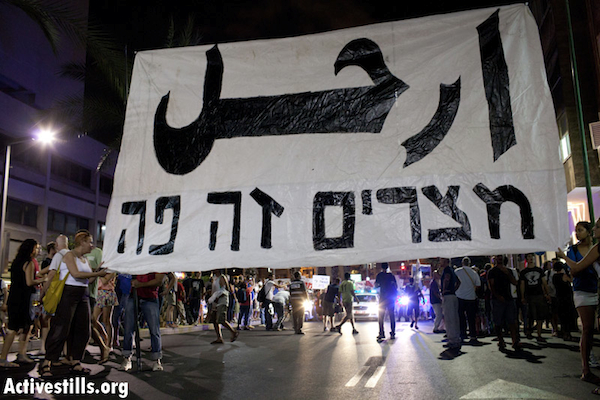The social justice demonstrations have been accused of ignoring the key issue of the occupation. But their tremendous groundswell of solidarity and cooperation is slowly gnawing at something even more significant than that – the principle of separation, of which the occupation is just one exercise.

One of the most impressive aspects of the J14 movement is how quickly it is snowballing, drawing more and more groups and communities into a torrent of discontent. Pouring out into the streets is everything that Israelis, of all national identities, creeds and most classes complained about for years: The climbing rents, the rising prices on fuel, the parenting costs, the free-fall in the quality of public education, the overworked, unsustainable healthcare system, the complete and utter detachment of most politicians, on most levels, from most of the nation.
All this has been obfuscated for decades by the conflict, by a perpetual state of emergency; one of the benefits from leaving the occupation outside the protests, for now, was to neutralise the entire discourse of militarist fear-mongering. Contrary to what Dahlia and Joseph wrote last week, the government so far utterly failed to convince the people military needs must come before social justice; Iran has largely vanished from the news pages, and attempts to scare Israelis with references to a possible escalation with Lebanon or the Palestinian are relegated to third, fourth and fifth places in the headlines, with the texts often written in a sarcastic tone rarely employed in Israeli media on “serious” military matters.
Over the past week, though, the Palestinians themselves have begun gaining presence in the protests; not as an external threat or exclusively as monolithic victims of a monolithic Israel, but as a part and parcel of the protest movement, with their demands to rectify injustices unique to the Palestinians organically integrating with demands made by the protests on behalf of all Israelis.
First, a tent titled “1948” was pitched on Rothschild boulevard, housing Palestinian and Jewish activists determined to discuss Palestinian collective rights and Palestinian grievances as a legitimate part of the protests. They activists tell me the arguments are exhaustive, wild and sometimes downright strange; but unlike the ultra-right activists who tried pitching a tent calling for a Jewish Tel Aviv and hoisting homophobic signs, the 1948 tenters were not pushed out, and are fast becoming part of the fabric of this “apolitical” protest.
A few days after the 1948 tent was pitched, the council of the protests – democratically elected delegates from 40 protest camps across the country – published their list of demands, including, startlingly, two of the key social justice issues unique to the Palestinians within Israel: Sweeping recognition of unrecognised Bedouin villages in the Negev; and expanding the municipal borders of Palestinian towns and villages to allow for natural development. The demands chimed in perfectly with the initial drive of the protest – lack of affordable housing.
The demands chimed in perfectly with the initial drive of the protest – lack of affordable housing. Neither issue has ever been included in the list of demands of a national, non-sectarian movement capable of bringing 300,000 people out into the streets.
And, finally, on Wednesday, residents of the Jewish poverty-stricken neighbourhood of Hatikva, many of them dyed-in-the-wool Likud activists, signed a covenant of cooperation with the Palestinian and Jewish Jaffa protesters, many of them activists with Jewish-Palestinian Hadash and nationalist-Palestinian Balad. They agreed they had more in common with each other than with the middle class national leadership of the protest, and that while not wishing to break apart from the J14 movement, they thought their unique demands would be better heard if they act together. At the rally, they marched together, arguing bitterly at times but sticking to each other, eventually even chanting mixed Hebrew and Arabic renditions of slogans from Tahrir.
Yesteday’s mega-rally was also where Palestinian partnership in the protests came to a head, when writer Odeh Bisharat spoke to nearly 300,000 people – overwhelmingly, centrist Israelis Jews – of the grievances of Palestinians in Israel and was met with raucous applause. I’ll return to that moment a little further below, but before that, perhaps I should explain why I think the participation of Palestinian citizens of Israel in the protests has more bearing on the conflict than any concentrated attempt to rally the crowds against the occupation.
On the most practical level, if the protesters had begun by blaming all of Israel’s social and political woes on the occupation, none of the breathtaking events of the past three weeks would have happened. They would have been written off as Israel-hating lefties and cast aside, just like every attempt to get mainstream Israelis to care for Palestinians before caring for themselves was cast aside for at least the past decade.
Altruist causes can rarely raise people to a sustained and genuine popular struggle against their own governments, and attempts to rally Israelis to the Palestinian cause for selfish reasons – i.e. for our own soldiers’ sake or because of the demographic time bomb – smacked of hypocrisy and ethnic nationalism; hypocrisy is a poor magnet for popular support, while ethnic nationalism is the natural instrument of the Right, not of the Left, which wields it awkwardly and usually to its own detriment.
It should be admitted, 11 years after the second Intifada, 18 years after the beginning of the peace process, that the Israeli left has utterly and abjectly failed to seriously enthuse Israelis in the project of ending the occupation. There was never a choice between a social struggle focused on the occupation and a social struggle temporarily putting the conflict aside, because the first attempt would have flopped . There was nothing to be gained by trying the same thing again for the Nth time. There have been many important victories in battles, but on the whole, the two-state left (as opposed to the two-state right) has lost the war.
The Occupation is just part of a bigger problem
But these were the tactical considerations valid only for the beginning of the protests. Social injustice does not exist in a vacuum, most certainly not in a conflict zone – and the problem in Israel-Palestine is much wider and deeper than the occupation. The occupation may be the most acute and violent injustice going on, and, like Aziz and I wrote in our New York Times op-ed last week, it’s certainly the greatest single obstacle to social justice on either side of the Green Line. But it’s still only one expression of an organising principle that has governed all of Israel-Palestine for at least the past sixty years: Separation.
Israel-Palestine today is, for all intents and purposes, a single political entity, with a single de-facto sovereign – the government in Jerusalem, but the populations this government controls, are divided into several levels of privilege. The broad outlines of the hierarchy are well-known – at the bottom are Palestinians of ’67, who can’t even vote for the regime that governs most areas of their lives and are subject to military and bureaucratic violence on a day to day basis; Palestinians of ’48, who can vote but are strongly and consistently discriminated and lack collective rights (which is a Jewish privilege); and finally the Israeli Jews.
But separation runs deeper than that: It employs and amplifies cultural and economic privilege to fracture each broad group into sub-groups, separating Druze from Bedouins from Palestinians, Ramallah residents from residents of Hebron, city residents from villagers, established residents from refugees; and within Jewish society, Mizrachis from Ashkenazis, settlers from green-line residents of Israel, ultra-Orthodox from secular, Russians from native-born Israelis, Ethiopians from everyone else, and so on.
The separation system is so chaotic even its privileges are far from self evident: ultra-Orthodox and settlers are seen as the communities most benefiting from the status quo, but it is important to remember the actual socio-economic standing of both is rather weak, and many in both are not only beneficiaries, but also hostages – the ultra-Orthodox to sectorial parties, the settlers to the occupation. And the occupation itself is just an instrument of separation: Its long term purpose is to acquire maximum land with a minimum of Palestinian on it, but for the past 40 years it mainly ensured half the population under the control of a certain government would have no recourse or representation with that government on any level.
And while the issue of the occupation remains to be engaged with directly in the #j14 movement, the very dynamic of the protests is already gnawing at the foundation on which the occupation rests – the separation axiom. Haggai Matar is a veteran anti-occupation activist, with a prison term for conscientious objection to serve in the IDF and countless West Bank protests under his belt. There are few people in Israel more committed to ending the occupation than him. And yet this is how he writes of yesterday’s rally:
Odeh Bisharat, the first Arab to address the mass rallies, greeted the enormous audience before him and reminded them that the struggle for social justice has always been the struggle of the Arab community, which has suffered from inequality, discrimination, state-level racism and house demolitions in Ramle, Lod, Jaffa and Al-Araqib. Not only was this met with ovation from a huge crowd of well over a hundred thousand people, but the masses actually chanted: “Jews and Arabs refuse to be enemies.” And later, in a short clip of interviews from protest camps across the country, Jews and Arabs spoke, and a number of them, including even one religious Jew, repeatedly said that “it’s time for this state to be a state for all its citizens.” A state for all its citizens. As a broad, popular demand. Who would have believed it.
It would be seriously far-fetched to assume the protesters are deliberately trying to pull down the entire meshwork of rifts and boundaries. But one of the many unexpected consequences of this movement – indeed, the movement itself is an avalanche of completely unexpected consequences – is that these boundaries are beginning to blur and to seem less relevant than what brings people together. We have failed to end the occupation by confronting it head on, but the boundary-breaking, de-segregating movement could, conceivably, undermine it.
Like Noam wrote earlier today, it’s still too soon to tell where the movement will eventually go, and “it can even bring Israel further to the right; it certainly won’t be the first time in history in which social unrest led to the rise of rightwing demagogue – but right now, it is creating a space for a new conversation. Limited as this space may be, it’s so much more than we had just a month ago.” The slow erosion of separation lines means there are also possibilities opening up for new conversation about the Jewish-Palestinian divide – including the occupation.

